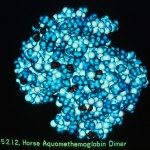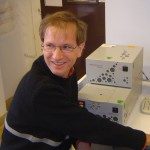Link to Pubmed [PMID] – 12167537
FEMS Microbiol. Lett. 2002 Aug;213(2):193-7
The autolysin AtlC is the only known fibronectin-binding protein in Staphylococcus caprae strain 96007. The fibronectin-binding domain of AtlC consists of three repeats (AtlCR(1)R(2)R(3)), which are located between the two enzymatic domains. The AtlCR(1)R(2)R(3) domain and the AtlCR(1)R(2) and AtlCR(3) subdomains were expressed separately as His(6)-tagged proteins. In Western affinity blots, only AtlCR(1)R(2)R(3) and AtlCR(3) but not AtlCR(1)R(2) appeared to recognise fibronectin; however, in ELISA and Biacore experiments, all three bound fibronectin. The interaction between AtlCR(1)R(2)R(3) and fibronectin is multivalent and involves high- and low-affinity sites that are present in a 2:1 ratio. These distinct classes of binding sites may be situated on either or on both ligands.

